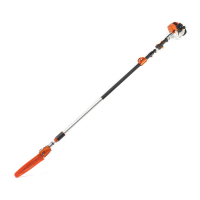HT 75
English
6
Work calmly and carefully – in daylight
conditions and only when visibility is
good. Proceed with caution, do not put
others in danger.
To reduce the risk of serious or fatal
injury from breathing toxic fumes,
ensure proper ventilation when working
in trenches, hollows or other confined
locations.
Stop work immediately if you start
suffering from nausea, headaches,
impaired vision (e.g. your field of vision
gets smaller), impaired hearing,
dizziness, or impaired concentration –
these symptoms may possibly be the
result of too-high exhaust gas
concentration – Risk of accidents!
Operate your power tool so that it
produces a minimum of noise and
emissions – do not run the engine
unnecessarily, accelerate the engine
only when working.
To reduce the risk of fire, do not smoke
while operating or standing near your
power tool. Combustible fuel vapor may
escape from the fuel system.
Dust (e.g. sawdust), fumes and smoke,
generated while using the machine, may
be hazardous to health. Wear a dust
mask in case of dust formation.
If your power tool is subjected to
unusually high loads for which it was not
designed (e.g. heavy impact or a fall),
always check that it is in good condition
before continuing work – see also
"Before Starting". Check in particular
that the fuel system has no leaks and the
safety equipment is fully operative.
Never use a power tool that is no longer
safe to operate. In case of doubt, contact
a dealer.
If you use a harness, ensure that the
exhaust gas flow is diverted away from
your body – Risk of fire!
Limbing
Hold the power tool at an angle. Do not
stand directly underneath the limb being
cut. Do not exceed an angle of 60° from
the horizontal. Watch for falling wood.
Keep the work area clear – remove
interfering limbs and brush.
Before sawing branches, establish an
escape route and remove all obstacles.
As soon as the engine is
running, the power
machine generates toxic
exhaust gas. These
gases may be odorless
and invisible and may
contain unburned hydro
-
carbons and benzene.
Never run the engine
indoors or in poorly venti
-
lated locations, even if
your model is equipped
with a catalytic converter.

